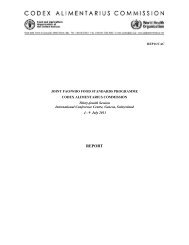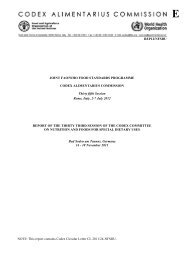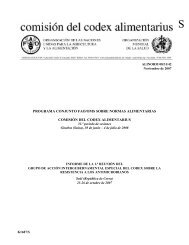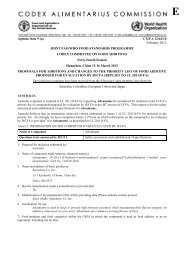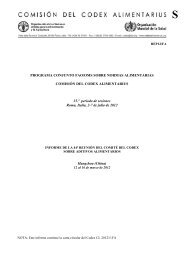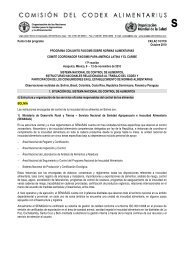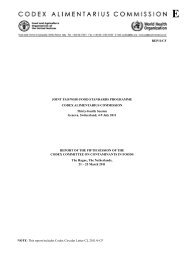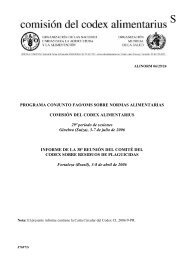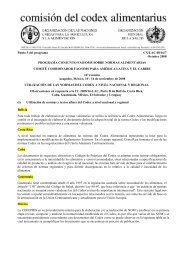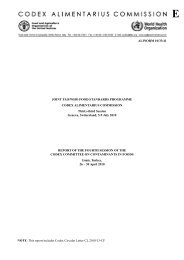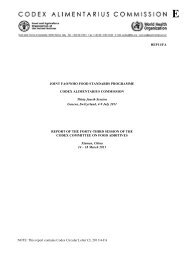JOINT FAO/WHO FOOD STANDARDS PROGRAMME ... - Cclac.org
JOINT FAO/WHO FOOD STANDARDS PROGRAMME ... - Cclac.org
JOINT FAO/WHO FOOD STANDARDS PROGRAMME ... - Cclac.org
Create successful ePaper yourself
Turn your PDF publications into a flip-book with our unique Google optimized e-Paper software.
ALINORM 07/30/24 Page 319. The Delegation of the EC indicated that while it appreciated the response from JMPR, thereconsiderations were not reported in sufficient detail and that the EC still upheld their original concern.20. Regarding indoxacarb, the 2006 JMPR reconsidered the critical studies and the critical toxic effectsand confirmed that the ADI for indoxacarb of 0-0.01 mg/kg bw established by the 2005 JMPR was stillappropriate. The Delegation of the EC noted that based on the detailed information provided in the JMPRreport their concern could be reconsidered.2.3 APPLICATION OF ALTERNATIVE GOOD AGRICULTURAL PRACTICES (GAP)21. Following the decision of the Committee at its 38th Session, JMPR applied for the first time theretrospective and prospective approach for compounds for which acute intake concerns existed. It had beendecided that when the ARfD is exceeded for a particular GAP and pesticide/commodity combination, JMPRshould consider alternative country GAPs with adequate supporting field trials in order to identify a GAPwhich could alleviate the acute intake concerns. The retrospective approach was used for three compoundsand the prospective approach for one compound.22. The Committee was informed that in all of the three retrospective evaluations the data were notadequate to propose lower MRLs that would resolve that acute intake concerns and that JMPR had suggestedthat the likelihood of finding an acceptable alternative GAP should be considered before a request forevaluation is made and the data are submitted to JMPR (see also Agenda Item 4 (a)).2.4 SHORT-TERM DIETARY INTAKE ASSESSMENT: UNCERTAINTIES IN THEINTERNATIONAL ESTIMATED SHORT-TERM INTAKE (IESTI) CALCULATION AND ITSINTERPRETATION23. The Committee received further clarification on the deterministic method used by JMPR for thecalculation of the IESTI including detailed information on the variables used in the equations for the IESTIcalculations and the uncertainty and variability associated with these variables.24. With the objective to improve the estimation of the short term dietary intake of pesticides and itsinterpretation, JMPR recommended that an international consultation could be held to address inter alia:• Uncertainty and variability of the parameters used in the estimation;• Ways to improve the consumption, unit weight and body weight data provided to the JMPR;• Identification of additional subgroups of the population for which the assessment should beconducted, e.g. toddlers;• The adequacy of the IESTI equations when residues from monitoring/enforcement data are used orthe need of a specific methodology for this application;• How to improve communication between JMPR and the risk managers and the public on the outputof the risk assessment.25. The JMPR Secretariat advised that both <strong>FAO</strong> and <strong>WHO</strong> are prepared to <strong>org</strong>anize such aconsultation but that this would require extra-budgetary resources. The Delegation of the EC highlywelcomed the recommendation to address these issues.2.5 UPDATE OF THE AUTOMATED SPREADSHEET APPLICATIONS FOR THECALCULATION OF DIETARY INTAKE: INTRODUCTION OF THE 13 GEMS/<strong>FOOD</strong>CONSUMPTION CLUSTER DIETS.26. The Committee was informed that the automated spread-sheet application, adopted by the 2003JMPR to harmonize and facilitate the calculation of dietary intake, was updated to include the 13 new<strong>WHO</strong>/GEMS/Food consumption cluster diets. The JMPR Secretariat, also on behalf of GEMS/Food, thankedthe Dutch National Institute for Public Health and the Environment and the French Food Safety Authority fortheir assistance in this important work. The Committee was informed that there were difficulties in thisprocess because the Codex Classification for Food and Feed does not always match <strong>FAO</strong> Food BalanceSheet data, on which the cluster diets were based and that harmonization of the two data sets would facilitateupdating the cluster diets in the future. The Committee was also informed that implementation of the 13cluster diets had resulted in increased consumption of certain foods in some diets and that there was anoverall increase in food consumption. The JMPR Secretariat advised that the average body weights will have



